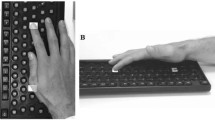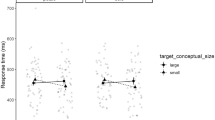Abstract
Seeing large or small objects in a choice-reaction task facilitates power and precision grip, respectively. According to the motor-simulation account, this congruity effect reflects an automatic access to object representation, including the grip usually associated to the object. Alternatively, this effect might come from an overlap between magnitude codes of the manipulable objects and those of the response’s outcomes. In Experiment 1, participants saw objects usually grasped with power or precision grip and had to mimic these gestures on a specific device. Large-switch responses (e.g., power grip) always produced a high-pitch tone (i.e., a small magnitude perceptual outcome) while small-switch responses (e.g., precision grip) always produced a low-pitch tone (i.e., a large magnitude perceptual outcome). We also manipulated the instructions asking one group to perform specific grips, while the other had to produce specific pitch tones. Even if results revealed shorter RTs in the object-response compatible condition compared to the non-compatible condition for both conditions, they also revealed a decrease of the congruity effect in the tone-instruction group (+ 13 ms) compared to the switch-instruction group (+ 25 ms). We conducted a second experiment based on the tone-instruction group but the response device was installed horizontally. Thus, the grasping component of the responses was removed as in Heurley et al. (2020). Results revealed a congruity effect supporting the magnitude coding account instead of the motor-simulation account. Results also seem to support a kind of permeability of the coding to the influence of intentional processes related to the processing of action outcomes.


Similar content being viewed by others
Data availability
The datasets, the stimuli, and the E-Prime script of the experiments are available at https://osf.io/rmkj4/.
Notes
In the literature, this effect is frequently known as the “potentiation effect” (e.g., Barsalou, 2008; Ellis & Tucker, 2000; Tucker & Ellis, 2001). However, as this terminology often implies a motor-simulation process, we prefer use the term “congruity effect” to avoid confusion regarding the interpretation of this effect.
We did not focus on the effect of lateralized responses initially reported by Tucker and Ellis (1998) because a lot of studies have been already developed to demonstrate that the spatial coding account better explain this effect (for a review, see Proctor & Miles, 2014; for a metanalysis, see Azaad et al., 2019).
The mapping between grasping responses (power grip vs. precision grip) and colours (orange vs. blue) was counterbalanced between participants as much as possible with a random assignation. Thus, for the switch-instruction group, both mapping group “power grip/blue-precision grip/orange” and “power grip/orange-precision grip/blue” are of 21 participants. For the tone-instruction group, the mapping groups are of 22 and 20 participants, respectively.
Therefore, like for the switch-instruction group, the mapping between each response (high-pitch tone vs. low-pitch tone) and colours (orange vs. blue) was counterbalanced between participants. There are also two subgroups, each composed of 21 randomly assigned participants.
References
Alais, D., & Burr, D. (2004). The ventriloquist effect results from near-optimal bimodal integration. Current Biology, 14(3), 257–262.
American Psychological Association. (2017). Ethical principles of psychologists and code of conduct. American Psychological Association. https://www.apa.org/ethics/code/ethics-code-2017.pdf.
Ansorge, U., & Wühr, P. (2004). A response-discrimination account of the Simon Effect. Journal of Experimental Psychology: Human Perception and Performance, 30(2), 365–377. https://doi.org/10.1037/0096-1523.30.2.365.
Azaad, S., Laham, S. M., & Shields, P. (2019). A meta-analysis of the object-based compatibility effect. Cognition, 190, 105–127. https://doi.org/10.1016/j.cognition.2019.04.028.
Barsalou, L. W. (2008). Grounded Cognition. Annual Review of Psychology, 59(1), 617–645. https://doi.org/10.1146/annurev.psych.59.103006.093639.
Borghi, A. M., & Riggio, L. (2015). Stable and variable affordances are both automatic and flexible. Frontiers in Human Neuroscience, 9, https://doi.org/10.3389/fnhum.2015.00351.
Bub, D. N., Masson, M. E. J., & Cree, G. S. (2008). Evocation of functional and volumetric gestural knowledge by objects and words. Cognition, 106(1), 27–58. https://doi.org/10.1016/j.cognition.2006.12.010.
Bub, D. N., Masson, M. E. J., & Kumar, R. (2018). Time course of motor affordances evoked by pictured objects and words. Journal of Experimental Psychology: Human Perception and Performance, 44(1), 53–68. https://doi.org/10.1037/xhp0000431.
Buhlmann, I., Umiltà, C., & Wascher, E. (2007). Response coding and visuomotor transformation in the Simon task: The role of action goals. Journal of Experimental Psychology: Human Perception and Performance, 33(6), 1269–1282. https://doi.org/10.1037/0096-1523.33.6.1269.
Cousineau, D. (2017). Varieties of confidence intervals. Advances in Cognitive Psychology, 13(2), 140–155. https://doi.org/10.5709/acp-0214-z.
Cumming, G. (2014). The New Statistics: Why and how. Psychological Science, 25(1), 7–29. https://doi.org/10.1177/0956797613504966.
Ellis, R. (2007). Grounding visual object representation in action. In B. Wallace, A. Ross, J. Davies, & T. Anderson (Éds.), The mind, the body and the world: Psychology after cognitivism? (2007-08849-012; p. 309–326). Imprint Academic.
Ellis, R., & Tucker, M. (2000). Micro-affordance: The potentiation of components of action by seen objects. British Journal of Psychology, 91(4), 451–471. https://doi.org/10.1348/000712600161934.
Ernst, M. O., & Banks, M. S. (2002). Humans integrate visual and haptic information in a statistically optimal fashion. Nature, 415(6870), 429–433.
Faul, F., Erdfelder, E., Lang, A. G., & Buchner, A. (2007). G*Power 3: A flexible statistical power analysis program for the social, behavioral, and biomedical sciences. Behavior Research Methods, 39(2), 175–191. https://doi.org/10.3758/BF03193146.
Glenberg, A. M. (1997). What memory is for. Behavioral and brain sciences, 20(1), 1–19.
Grosjean, M., & Mordkoff, J. T. (2002). Post-response stimulation and the Simon effect: Further evidence of action-effect integration. Visual Cognition, 9(4–5), 528–539. https://doi.org/10.1080/13506280143000566.
Guerineau, R., Heurley, L. P., Morgado, N., Brouillet, D., & Dru, V. (2021). Anticipating the magnitude of response outcomes can induce a potentiation effect for manipulable objects. Psychological Research Psychologische Forschung. https://doi.org/10.1007/s00426-021-01535-0.
Guiard, Y. (1983). The lateral coding of rotations: A study of the Simon effect with wheel-rotation responses. Journal of Motor Behavior, 15(4), 331–342.
Haddad, L., Wamain, Y., & Kalénine, S. (2023). Stimulus-response compatibility effects during object semantic categorisation: Evocation of grasp affordances or abstract coding of object size? Quarterly Journal of Experimental Psychology. https://doi.org/10.1177/1747021823116131.
Harrak, M. H., Heurley, L. P., Morgado, N., Mennella, R., & Dru, V. (2022). The visual size of graspable objects is needed to induce the potentiation of grasping behaviors even with verbal stimuli. Psychological Research Psychologische Forschung. https://doi.org/10.1007/s00426-021-01635-x.
Heurley, L. P., & Ferrier, L. P. (2015). What are memory-perception interactions for? Implications for action. Frontiers in Psychology, 5, 1553.
Heurley, L. P., Brouillet, T., Coutté, A., & Morgado, N. (2020). Size coding of alternative responses is sufficient to induce a potentiation effect with manipulable objects. Cognition, 205, 104377. https://doi.org/10.1016/j.cognition.2020.104377.
Heurley, L. P., Harrak, M. H., Guerineau, R., Ferrier, L. P., & Morgado, N. (2023). The visual size is enough to automatically induce the potentiation of grasping behaviors. Quarterly Journal of Experimental Psychology. https://doi.org/10.1177/17470218231155836.
Hommel, B. (1993). Inverting the Simon effect by intention: Determinants of direction and extent of effects of irrelevant spatial information. Psychological Research Psychologische Forschung, 55, 270–279.
Hommel, B. (1996). The cognitive representation of action: Automatic integration of perceived action effects. Psychological Research Psychologische Forschung, 59(3), 176–186. https://doi.org/10.1007/BF00425832.
Hommel, B. (2011). The Simon effect as tool and heuristic. Acta Psychologica, 136(2), 189–202. https://doi.org/10.1016/j.actpsy.2010.04.011.
Hommel, B. (2015). The theory of event coding (TEC) as embodied-cognition framework. Frontiers in Psychology, 6, https://doi.org/10.3389/fpsyg.2015.01318.
Hommel, B. (2019). Theory of Event Coding (TEC) V2.0: Representing and controlling perception and action. Attention Perception & Psychophysics, 81(7), 2139–2154. https://doi.org/10.3758/s13414-019-01779-4.
Hommel, B., Müsseler, J., Aschersleben, G., & Prinz, W. (2001). The theory of Event Coding (TEC): A framework for perception and action planning. Behavioral and Brain Sciences, 24(5), 849–878. https://doi.org/10.1017/S0140525X01000103.
Kornblum, S., Hasbroucq, T., & Osman, A. (1990). Dimensional overlap: Cognitive basis for stimulus-response compatibility–a model and taxonomy. Psychological Review, 97(2), 253.
Lu, C., & Proctor, R. W. (1995). The influence of irrelevant location information on performance: A review of the Simon and spatial Stroop effects. Psychonomic Bulletin & Review, 2(2), 174–207. https://doi.org/10.3758/BF03210959.
Makris, S., Hadar, A. A., & Yarrow, K. (2011). Viewing objects and planning actions: On the potentiation of grasping behaviours by visual objects. Brain and Cognition, 77(2), 257–264. https://doi.org/10.1016/j.bandc.2011.08.002.
Masson, M. E. J. (2015). Toward a deeper understanding of embodiment. Canadian Journal of Experimental Psychology/Revue Canadienne de Psychologie Expérimentale, 69(2), 159–164. https://doi.org/10.1037/cep0000055.
Matheson, H., White, N., & McMullen, P. (2015). Accessing embodied object representations from vision: A review. Psychological Bulletin, 141(3), 511–524. https://doi.org/10.1037/bul0000001.
Memelink, J., & Hommel, B. (2013). Intentional weighting: A basic principle in cognitive control. Psychological Research Psychologische Forschung, 77(3), 249–259. https://doi.org/10.1007/s00426-012-0435-y.
Parise, C. V., Spence, C., & Deroy, O. (2015). Understanding the correspondences: Introduction to the special issue on crossmodal correspondences. Multisensory Research, 29(1–3), 1–6. https://doi.org/10.1163/22134808-00002517.
Perugini, M., Gallucci, M., & Costantini, G. (2014). Safeguard Power as a Protection Against Imprecise Power estimates. Perspectives on Psychological Science, 9(3), 319–332. https://doi.org/10.1177/1745691614528519.
Pfister, R. (2019). Effect-based action control with body-related effects: Implications for empirical approaches to ideomotor action control. Psychological Review, 126(1), 153–161. https://doi.org/10.1037/rev0000140.
Proctor, R. W., & Miles, J. D. (2014). Does the concept of affordance add anything to explanations of stimulus-response compatibility effects? In B. H. Ross (Ed.), The psychology of learning and motivation., Vol. 60 (60 vol., pp. 227–266). Elsevier Academic Press.
Proctor, R. W., & Vu, K. P. L. (2006). Stimulus-response compatibility principles: Data, theory, and application. CRC/Taylor & Francis.
Reeve, T. G., & Proctor, R. W. (1990). The salient-features coding principle for spatial-and symbolic-compatibility effects. Advances in psychology (65 vol., pp. 163–180). North-Holland.
Roswarski, T. E., & Proctor, R. W. (2000). Auditory stimulus-response compatibility: Is there a contribution of stimulus-hand congruity? Psychological Research Psychologische Forschung, 63(2), 148–158. https://doi.org/10.1007/PL00008173.
Schneider, W., Eschman, A., & Zuccolotto, A. (2002). E-Prime user’s guide. Pittsburgh: Psychology Software Tools Inc.
Simon, J. R. (1969). Reactions toward the source of stimulation. Journal of Experimental Psychology, 81(1), 174–176. https://doi.org/10.1037/h0027448.
Simon, J. R. (1990). The effects of an irrelevant directional cue on human information processing. In R. W. Proctor, & T. G. Reeve (Eds.), Stimulus-response compatibility: An integrated perspective (pp. 31–86). Amsterdam: North-Holland.
The jamovi project (2021). jamovi. (Version 1.8) [Computer Software]. Retrieved from https://www.jamovi.org.
Theeuwes, M., Liefooghe, B., & De Houwer, J. (2014). Eliminating the Simon effect by instruction. Journal of Experimental Psychology: Learning Memory and Cognition, 40(5), 1470–1480. https://doi.org/10.1037/a0036913.
Tucker, M., & Ellis, R. (1998). On the relations between seen objects and components of potential actions. Journal of Experimental Psychology: Human Perception and Performance, 24(3), 830–846. https://doi.org/10.1037/0096-1523.24.3.830.
Tucker, M., & Ellis, R. (2001). The potentiation of grasp types during visual object categorization. Visual Cognition, 8(6), 769–800. https://doi.org/10.1080/13506280042000144.
Tucker, M., & Ellis, R. (2004). Action priming by briefly presented objects. Acta Psychologica, 116(2), 185–203. https://doi.org/10.1016/j.actpsy.2004.01.004.
Veale, J. F. (2014). Edinburgh Handedness Inventory—Short Form: A revised version based on confirmatory factor analysis. Laterality: Asymmetries of Body Brain and Cognition, 19(2), 164–177. https://doi.org/10.1080/1357650X.2013.783045.
Wang, D. Y. D., Proctor, R. W., & Pick, D. F. (2007). Coding controlled and triggered cursor movements as action effects: Influences on the auditory Simon effect for wheel-rotation responses. Journal of Experimental Psychology: Human Perception and Performance, 33(3), 657–669. https://doi.org/10.1037/0096-1523.33.3.657.
Wilson, M. (2002). Six views of embodied cognition. Psychonomic bulletin & review, 9, 625–636.
Zwosta, K., Ruge, H., & Wolfensteller, U. (2013). No anticipation without intention: Response–effect compatibility in effect-based and stimulus-based actions. Acta Psychologica, 144(3), 628–634. https://doi.org/10.1016/j.actpsy.2013.09.014.
Author information
Authors and Affiliations
Corresponding authors
Ethics declarations
Conflict of interest
We have no conflict of interest to disclosed.
Human participants
All procedures conducted in our studies involving human participants were in accordance with the ethical standards of the institutional research committee and with the 1964 Helsinki declaration and its later amendments or comparable ethical standards.
Informed consent
Informed consent was obtained from all individual participants included in the study.
Additional information
Publisher’s Note
Springer Nature remains neutral with regard to jurisdictional claims in published maps and institutional affiliations.
Electronic supplementary material
Below is the link to the electronic supplementary material.
Rights and permissions
Springer Nature or its licensor (e.g. a society or other partner) holds exclusive rights to this article under a publishing agreement with the author(s) or other rightsholder(s); author self-archiving of the accepted manuscript version of this article is solely governed by the terms of such publishing agreement and applicable law.
About this article
Cite this article
Guerineau, R., Heurley, L., Sabek, H. et al. The verbal instruction in favour of action effects can influence the congruity effect of grasping behaviours. Curr Psychol 43, 7974–7985 (2024). https://doi.org/10.1007/s12144-023-04995-2
Accepted:
Published:
Issue Date:
DOI: https://doi.org/10.1007/s12144-023-04995-2




